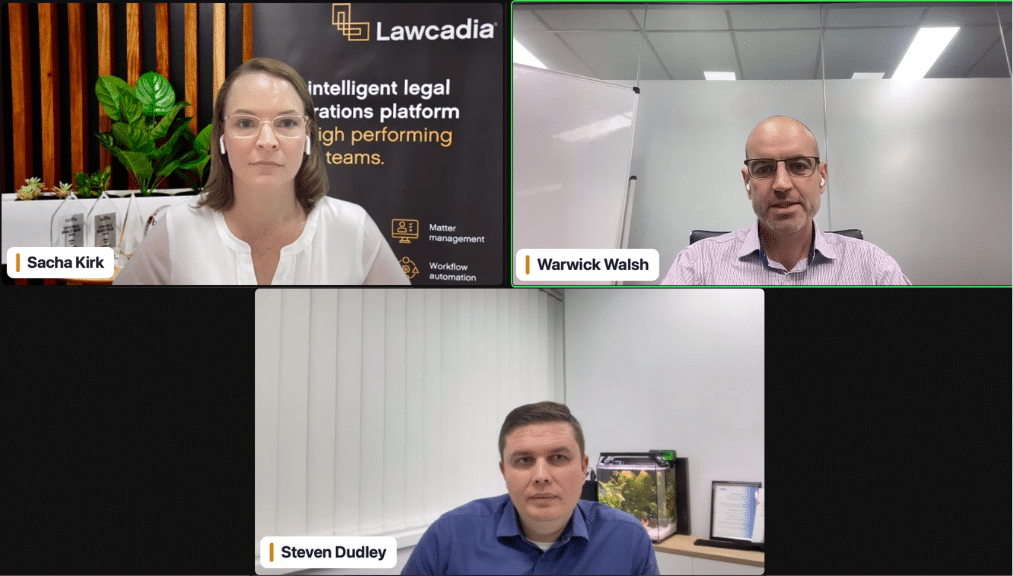During our recent webinar, ‘Getting the most from your legal spend with RFPs, process controls, and rate card compliance,’ Warwick Walsh, Lawcadia’s CEO and Co-founder, provided perceptive insights on mastering pre- and post-engagement process controls for in-house legal efficiency.
To understand these insights, it’s essential to delve into the mechanisms that precede and follow external legal counsel’s engagement and discuss the importance of process controls in managing legal spend for in-house teams. Process controls serve as a vital cog in the machinery of legal operations, ensuring that the fiscal outlay aligns with the strategic objectives and yields the best possible return on investment.
Effective process controls before and after engaging external counsel are not just about pinching pennies; they are about maximising value and ensuring that company resources are spent judiciously.
Pre-Engagement Process Controls
1. Business Briefs Legal (Legal Intake)
The inception of spend management begins with the legal intake process. This initial step involves a meticulous assessment of the business’s legal requirements, often through a structured form or portal that captures structured information as a legal request. It’s a gatekeeping mechanism ensuring that only valid, essential matters progress to external counsel, thereby preventing unnecessary spend and focusing resources on critical issues.
2. Out-Source vs In-Source Decision Making
Deciding whether to in-source or outsource legal work is a strategic choice with significant financial implications. Warwick Walsh encapsulates this dilemma, noting that it pivots on the internal team’s capability and capacity to handle the work versus the necessity of enlisting outside counsel for complex, high-stakes transactions or litigation. This reflective process steers the organisation from incurring external legal costs when internal resources are available and sufficiently skilled.
3. Law Firm Selection
Selecting a law firm is akin to choosing a strategic partner. It’s not just about who can offer the lowest rate but who can provide the best value—a combination of quality, efficiency, and service. As Walsh mentioned, it’s about leveraging the panel process to retain and realise the value created during negotiations on rates and fixed fees for high-volume work.
4. Direct Engagements vs Matter-Based RFP
The nature of the legal matter often dictates whether to engage firms directly or through a competitive RFP process. While direct engagements can streamline the acquisition of services for routine matters, a matter-based RFP process ensures that, for complex cases, or for matters over a certain value, you are getting competitive pricing and selecting a firm that strategically aligns with the specific requirements.
5. Servicing Levels
Clearly defining service levels means setting expectations for engaged law firms’ delivery. As Walsh articulates, it’s crucial to have a clear scope of work agreed upon – it’s about the calibration of service to need, ensuring that firms provide neither more nor less than what’s required.
6. Agree the Scope of Work and Budget
The agreed scope of work and budget establishes the financial and operational boundaries of the engagement. This step is about foresight and clarity, ensuring that both parties understand the extent of the legal services required and the corresponding fees, safeguarding against scope creep and unexpected costs.
7. Engage Law Firm
The engagement of the law firm is the culmination of the pre-engagement process, marking the transition from planning to action. This phase solidifies the negotiated terms and expectations, formalising the partnership and setting the foundation for the matter’s handling.
Post-Engagement Process Controls
1. Managing Changes to Scope of Work and Budget
Changes in scope and budget are almost inevitable. Effective post-engagement controls provide a structured process for reviewing and approving these changes, ensuring they are justified and aligned with the business’s evolving needs.
2. Approvals and Escalations
A systematised approach to approvals and escalations is essential in maintaining spend discipline. This process should be clear and straightforward, enabling prompt decision-making while ensuring accountability and transparency, especially in high-value or fast-moving deals or matters.
3. Monitoring Work in Progress
Continuous monitoring of work in progress (WIP) allows for a real-time assessment of legal spend versus budget and legal progress versus plan. This oversight is vital to detect and address deviations early, avoiding surprises and enabling proactive management of legal matters.
4. Receiving and Approving Invoices
Invoicing should be scrutinised rigorously, ensuring that charges align with the agreed-upon rates and the scope of work. It’s a critical checkpoint in spend management, where discrepancies must be identified and resolved. Utilising automated rate card compliance functionality allows legal teams to stay on top of compliance while minimising the time spent on this task.
5. Matter Completion
The closure of a matter should trigger a review to confirm that all deliverables have been met. This phase involves a thorough post-mortem analysis to ensure objectives were achieved and to identify lessons learned for future engagements.
6. Close the Loop with Feedback and Evaluation
A feedback loop with law firms fosters a culture of continuous improvement. Post-engagement evaluations can reinforce successful strategies and correct misalignments in expectations or performance. This also presents an opportunity to invite feedback from the law firms on the quality of the instructions received.
7. Data Capture and Reporting
Finally, data capture and thorough reporting serve as the lynchpins of process control. This step is where in-house teams harvest insights from their engagements. As Walsh underscores, data capture is not just about evaluating the past but also informing future interactions and negotiations with law firms. It’s a strategic exercise in understanding trends, spend patterns, and the efficacy of the legal advice received.
Regular reporting also ensures visibility for key stakeholders and provides a basis for those crucial quarterly or biannual reviews. During these reviews, the behaviour and performance of both in-house and law firm teams are examined, not just on individual matters but from a holistic client-law firm perspective. This comprehensive view is crucial for informed decision-making and strategic planning.
Embedding Value in Every Step
To circle back to Warwick Walsh’s insights, there’s more value to be created pre-engagement by inviting the right firms to pitch for a particular matter and evaluating the value proposition of their response. Then, the ongoing post-engagement vigilance cements this value, ensuring compliance and adherence to the strategic framework established at the outset.
Walsh aptly notes that while post-engagement activities may seem compliance-driven, they are equally crucial in strengthening the perceived value of the legal function. The controls implemented after the law firm is engaged are pivotal in ensuring the relationship yields the intended benefits, both in terms of legal outcomes and cost management.
Conclusion
The importance of process controls in managing legal spend cannot be overstated. They are how in-house legal teams can align their work with the business’s strategic imperatives, ensuring legal services are delivered efficiently, effectively, and with tangible value. This dynamic demands both rigorous discipline and strategic foresight—a combination that underlies the core of every successful in-house legal team.
Want to learn more? Watch a recording of the EMEA webinar here.
This article was originally published on our sister site lawcadia.com.

